Comprehensive Report: TESCO Business Operations and Strategy
VerifiedAdded on 2020/09/17
|12
|3008
|36
Report
AI Summary
This report provides a detailed analysis of TESCO's business operations. It begins with a classification of private and public organizations, followed by an examination of organizational structures and the impact of economic environments. The report then delves into the significance of accounting for business success, exploring the functions of the HR department and key elements of employment legislation. A profit and loss interpretation of TESCO is included, along with an analysis of team roles, team development stages, and motivation theories. Different leadership styles and the impact of customer service and customer retention are also discussed, providing a comprehensive overview of TESCO's business practices and strategies.
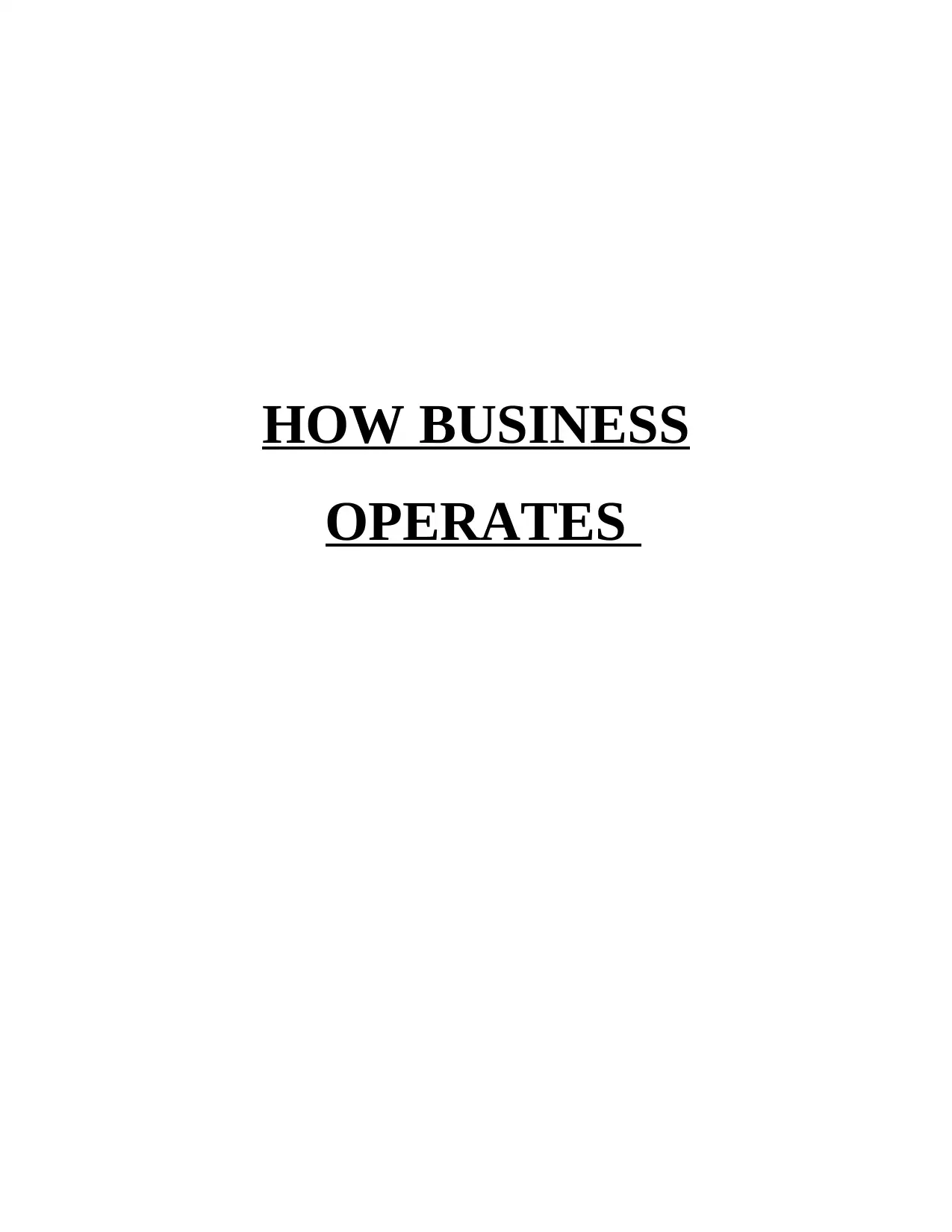
HOW BUSINESS
OPERATES
OPERATES
Paraphrase This Document
Need a fresh take? Get an instant paraphrase of this document with our AI Paraphraser
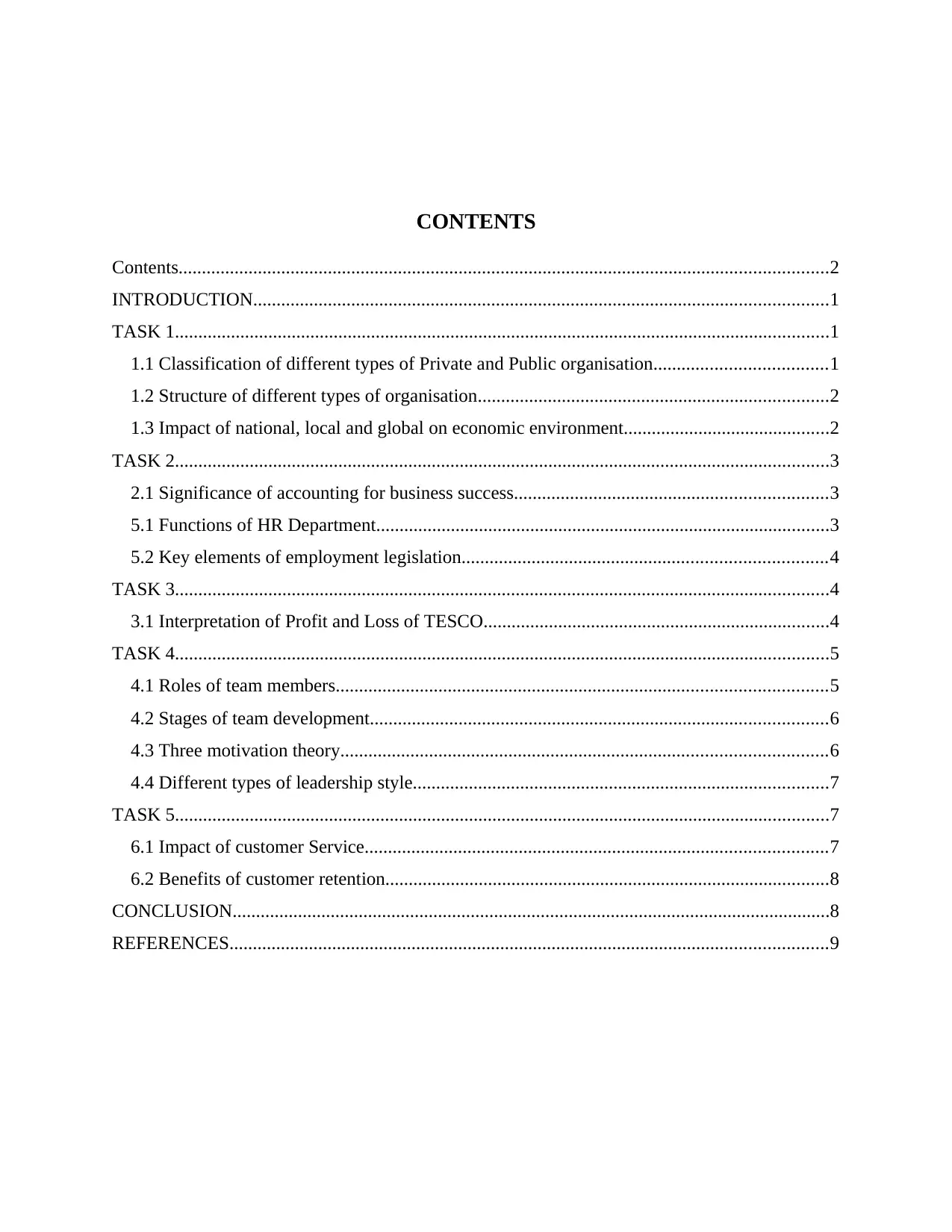
CONTENTS
Contents...........................................................................................................................................2
INTRODUCTION...........................................................................................................................1
TASK 1............................................................................................................................................1
1.1 Classification of different types of Private and Public organisation.....................................1
1.2 Structure of different types of organisation...........................................................................2
1.3 Impact of national, local and global on economic environment............................................2
TASK 2............................................................................................................................................3
2.1 Significance of accounting for business success...................................................................3
5.1 Functions of HR Department.................................................................................................3
5.2 Key elements of employment legislation..............................................................................4
TASK 3............................................................................................................................................4
3.1 Interpretation of Profit and Loss of TESCO..........................................................................4
TASK 4............................................................................................................................................5
4.1 Roles of team members.........................................................................................................5
4.2 Stages of team development..................................................................................................6
4.3 Three motivation theory........................................................................................................6
4.4 Different types of leadership style.........................................................................................7
TASK 5............................................................................................................................................7
6.1 Impact of customer Service...................................................................................................7
6.2 Benefits of customer retention...............................................................................................8
CONCLUSION................................................................................................................................8
REFERENCES................................................................................................................................9
Contents...........................................................................................................................................2
INTRODUCTION...........................................................................................................................1
TASK 1............................................................................................................................................1
1.1 Classification of different types of Private and Public organisation.....................................1
1.2 Structure of different types of organisation...........................................................................2
1.3 Impact of national, local and global on economic environment............................................2
TASK 2............................................................................................................................................3
2.1 Significance of accounting for business success...................................................................3
5.1 Functions of HR Department.................................................................................................3
5.2 Key elements of employment legislation..............................................................................4
TASK 3............................................................................................................................................4
3.1 Interpretation of Profit and Loss of TESCO..........................................................................4
TASK 4............................................................................................................................................5
4.1 Roles of team members.........................................................................................................5
4.2 Stages of team development..................................................................................................6
4.3 Three motivation theory........................................................................................................6
4.4 Different types of leadership style.........................................................................................7
TASK 5............................................................................................................................................7
6.1 Impact of customer Service...................................................................................................7
6.2 Benefits of customer retention...............................................................................................8
CONCLUSION................................................................................................................................8
REFERENCES................................................................................................................................9

⊘ This is a preview!⊘
Do you want full access?
Subscribe today to unlock all pages.

Trusted by 1+ million students worldwide
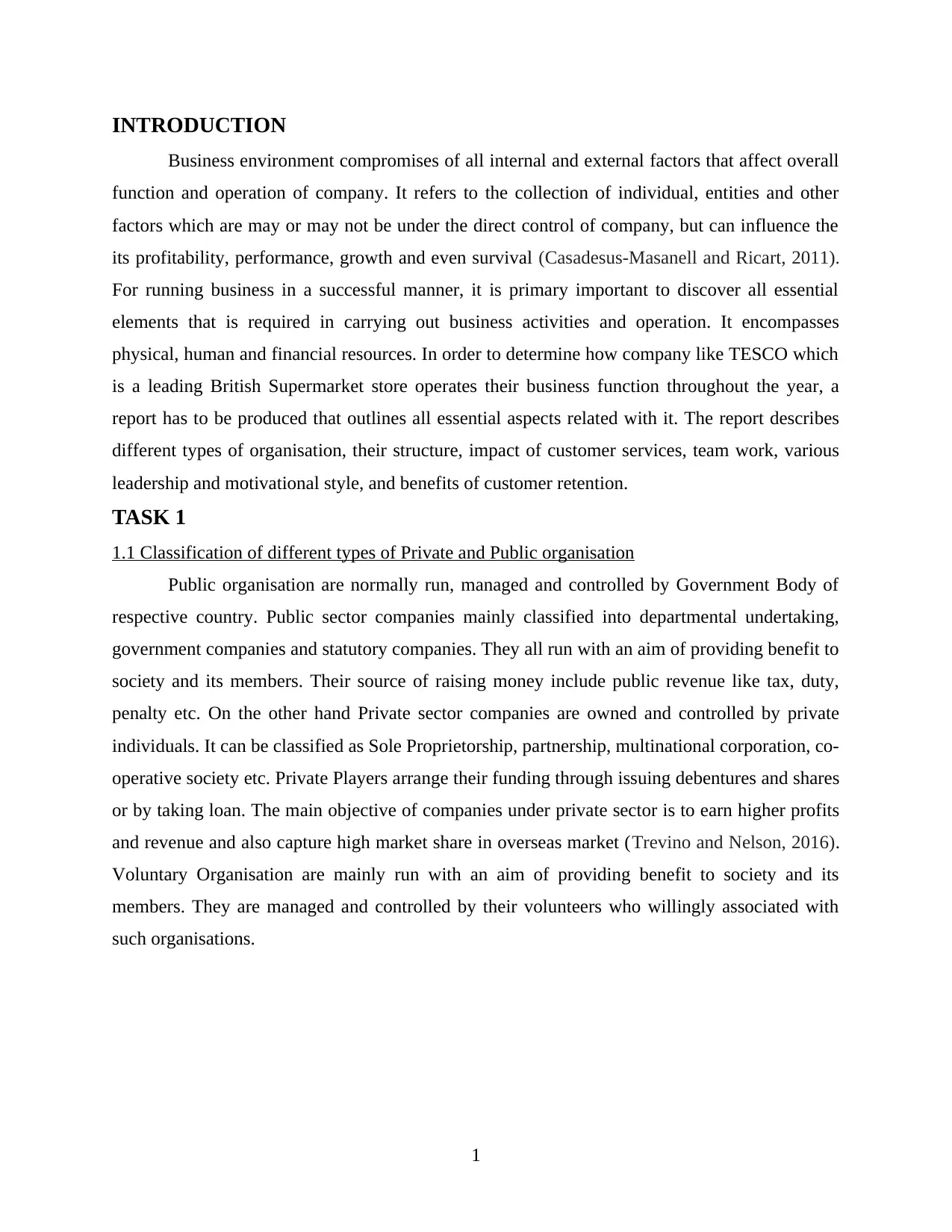
INTRODUCTION
Business environment compromises of all internal and external factors that affect overall
function and operation of company. It refers to the collection of individual, entities and other
factors which are may or may not be under the direct control of company, but can influence the
its profitability, performance, growth and even survival (Casadesus-Masanell and Ricart, 2011).
For running business in a successful manner, it is primary important to discover all essential
elements that is required in carrying out business activities and operation. It encompasses
physical, human and financial resources. In order to determine how company like TESCO which
is a leading British Supermarket store operates their business function throughout the year, a
report has to be produced that outlines all essential aspects related with it. The report describes
different types of organisation, their structure, impact of customer services, team work, various
leadership and motivational style, and benefits of customer retention.
TASK 1
1.1 Classification of different types of Private and Public organisation
Public organisation are normally run, managed and controlled by Government Body of
respective country. Public sector companies mainly classified into departmental undertaking,
government companies and statutory companies. They all run with an aim of providing benefit to
society and its members. Their source of raising money include public revenue like tax, duty,
penalty etc. On the other hand Private sector companies are owned and controlled by private
individuals. It can be classified as Sole Proprietorship, partnership, multinational corporation, co-
operative society etc. Private Players arrange their funding through issuing debentures and shares
or by taking loan. The main objective of companies under private sector is to earn higher profits
and revenue and also capture high market share in overseas market (Trevino and Nelson, 2016).
Voluntary Organisation are mainly run with an aim of providing benefit to society and its
members. They are managed and controlled by their volunteers who willingly associated with
such organisations.
1
Business environment compromises of all internal and external factors that affect overall
function and operation of company. It refers to the collection of individual, entities and other
factors which are may or may not be under the direct control of company, but can influence the
its profitability, performance, growth and even survival (Casadesus-Masanell and Ricart, 2011).
For running business in a successful manner, it is primary important to discover all essential
elements that is required in carrying out business activities and operation. It encompasses
physical, human and financial resources. In order to determine how company like TESCO which
is a leading British Supermarket store operates their business function throughout the year, a
report has to be produced that outlines all essential aspects related with it. The report describes
different types of organisation, their structure, impact of customer services, team work, various
leadership and motivational style, and benefits of customer retention.
TASK 1
1.1 Classification of different types of Private and Public organisation
Public organisation are normally run, managed and controlled by Government Body of
respective country. Public sector companies mainly classified into departmental undertaking,
government companies and statutory companies. They all run with an aim of providing benefit to
society and its members. Their source of raising money include public revenue like tax, duty,
penalty etc. On the other hand Private sector companies are owned and controlled by private
individuals. It can be classified as Sole Proprietorship, partnership, multinational corporation, co-
operative society etc. Private Players arrange their funding through issuing debentures and shares
or by taking loan. The main objective of companies under private sector is to earn higher profits
and revenue and also capture high market share in overseas market (Trevino and Nelson, 2016).
Voluntary Organisation are mainly run with an aim of providing benefit to society and its
members. They are managed and controlled by their volunteers who willingly associated with
such organisations.
1
Paraphrase This Document
Need a fresh take? Get an instant paraphrase of this document with our AI Paraphraser
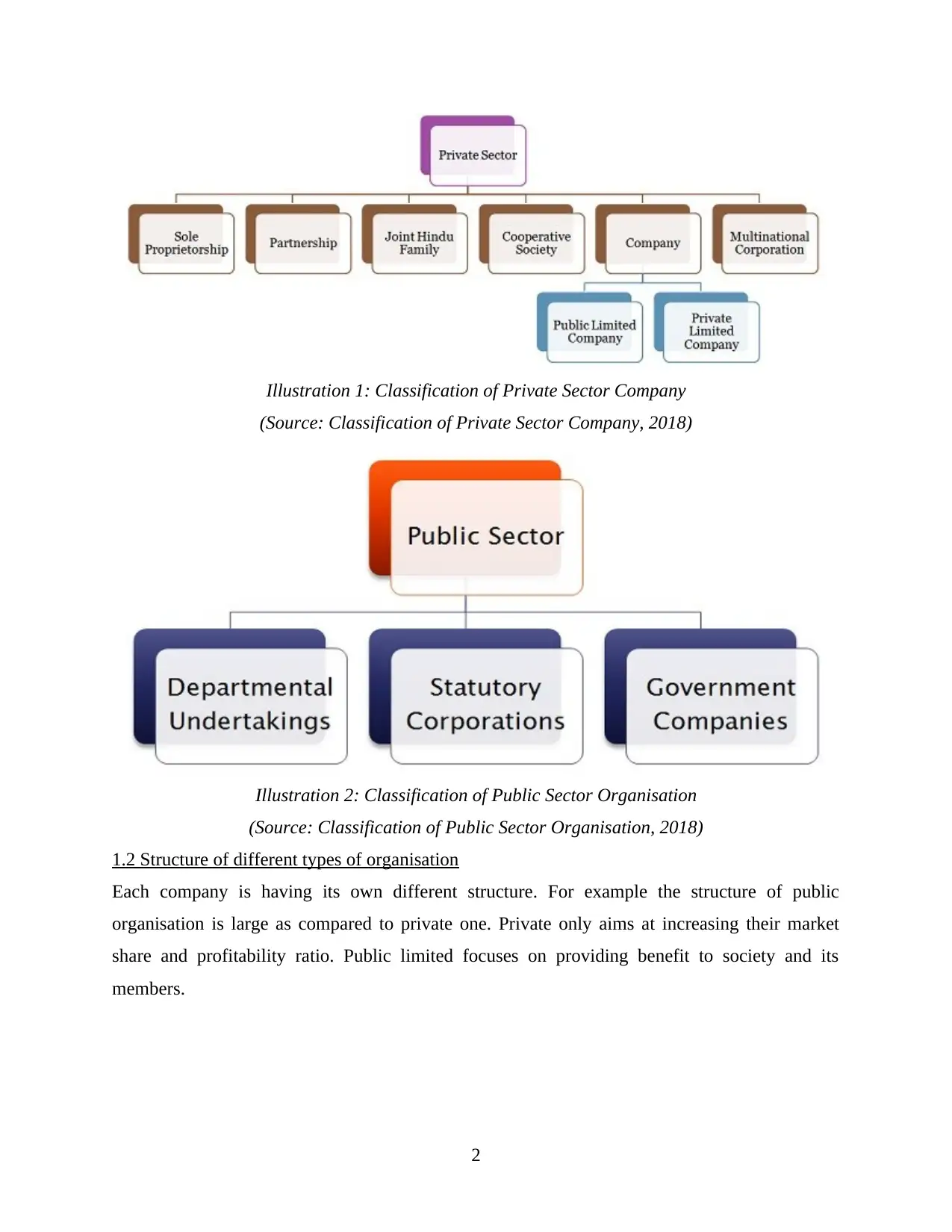
(Source: Classification of Private Sector Company, 2018)
(Source: Classification of Public Sector Organisation, 2018)
1.2 Structure of different types of organisation
Each company is having its own different structure. For example the structure of public
organisation is large as compared to private one. Private only aims at increasing their market
share and profitability ratio. Public limited focuses on providing benefit to society and its
members.
2
Illustration 1: Classification of Private Sector Company
Illustration 2: Classification of Public Sector Organisation
(Source: Classification of Public Sector Organisation, 2018)
1.2 Structure of different types of organisation
Each company is having its own different structure. For example the structure of public
organisation is large as compared to private one. Private only aims at increasing their market
share and profitability ratio. Public limited focuses on providing benefit to society and its
members.
2
Illustration 1: Classification of Private Sector Company
Illustration 2: Classification of Public Sector Organisation
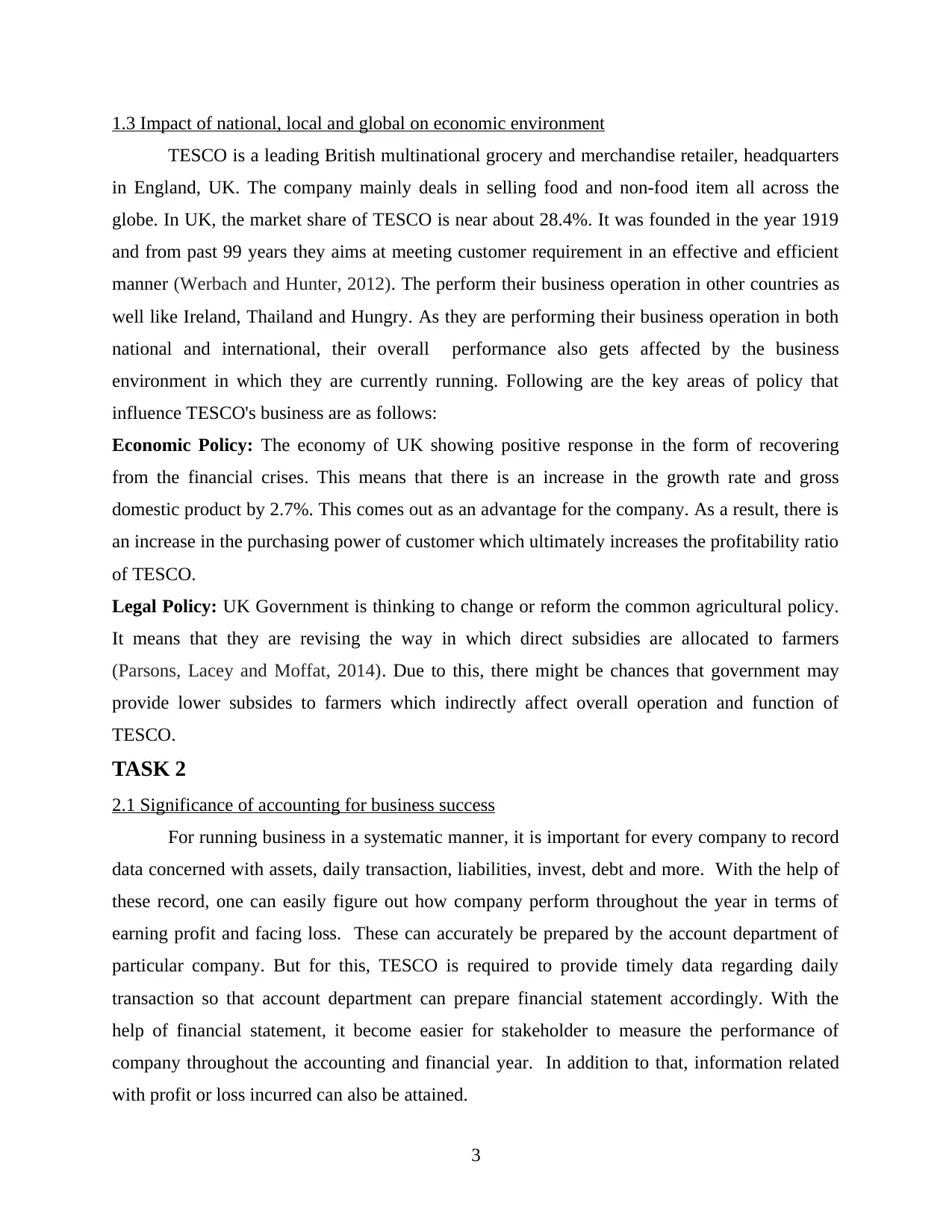
1.3 Impact of national, local and global on economic environment
TESCO is a leading British multinational grocery and merchandise retailer, headquarters
in England, UK. The company mainly deals in selling food and non-food item all across the
globe. In UK, the market share of TESCO is near about 28.4%. It was founded in the year 1919
and from past 99 years they aims at meeting customer requirement in an effective and efficient
manner (Werbach and Hunter, 2012). The perform their business operation in other countries as
well like Ireland, Thailand and Hungry. As they are performing their business operation in both
national and international, their overall performance also gets affected by the business
environment in which they are currently running. Following are the key areas of policy that
influence TESCO's business are as follows:
Economic Policy: The economy of UK showing positive response in the form of recovering
from the financial crises. This means that there is an increase in the growth rate and gross
domestic product by 2.7%. This comes out as an advantage for the company. As a result, there is
an increase in the purchasing power of customer which ultimately increases the profitability ratio
of TESCO.
Legal Policy: UK Government is thinking to change or reform the common agricultural policy.
It means that they are revising the way in which direct subsidies are allocated to farmers
(Parsons, Lacey and Moffat, 2014). Due to this, there might be chances that government may
provide lower subsides to farmers which indirectly affect overall operation and function of
TESCO.
TASK 2
2.1 Significance of accounting for business success
For running business in a systematic manner, it is important for every company to record
data concerned with assets, daily transaction, liabilities, invest, debt and more. With the help of
these record, one can easily figure out how company perform throughout the year in terms of
earning profit and facing loss. These can accurately be prepared by the account department of
particular company. But for this, TESCO is required to provide timely data regarding daily
transaction so that account department can prepare financial statement accordingly. With the
help of financial statement, it become easier for stakeholder to measure the performance of
company throughout the accounting and financial year. In addition to that, information related
with profit or loss incurred can also be attained.
3
TESCO is a leading British multinational grocery and merchandise retailer, headquarters
in England, UK. The company mainly deals in selling food and non-food item all across the
globe. In UK, the market share of TESCO is near about 28.4%. It was founded in the year 1919
and from past 99 years they aims at meeting customer requirement in an effective and efficient
manner (Werbach and Hunter, 2012). The perform their business operation in other countries as
well like Ireland, Thailand and Hungry. As they are performing their business operation in both
national and international, their overall performance also gets affected by the business
environment in which they are currently running. Following are the key areas of policy that
influence TESCO's business are as follows:
Economic Policy: The economy of UK showing positive response in the form of recovering
from the financial crises. This means that there is an increase in the growth rate and gross
domestic product by 2.7%. This comes out as an advantage for the company. As a result, there is
an increase in the purchasing power of customer which ultimately increases the profitability ratio
of TESCO.
Legal Policy: UK Government is thinking to change or reform the common agricultural policy.
It means that they are revising the way in which direct subsidies are allocated to farmers
(Parsons, Lacey and Moffat, 2014). Due to this, there might be chances that government may
provide lower subsides to farmers which indirectly affect overall operation and function of
TESCO.
TASK 2
2.1 Significance of accounting for business success
For running business in a systematic manner, it is important for every company to record
data concerned with assets, daily transaction, liabilities, invest, debt and more. With the help of
these record, one can easily figure out how company perform throughout the year in terms of
earning profit and facing loss. These can accurately be prepared by the account department of
particular company. But for this, TESCO is required to provide timely data regarding daily
transaction so that account department can prepare financial statement accordingly. With the
help of financial statement, it become easier for stakeholder to measure the performance of
company throughout the accounting and financial year. In addition to that, information related
with profit or loss incurred can also be attained.
3
⊘ This is a preview!⊘
Do you want full access?
Subscribe today to unlock all pages.

Trusted by 1+ million students worldwide
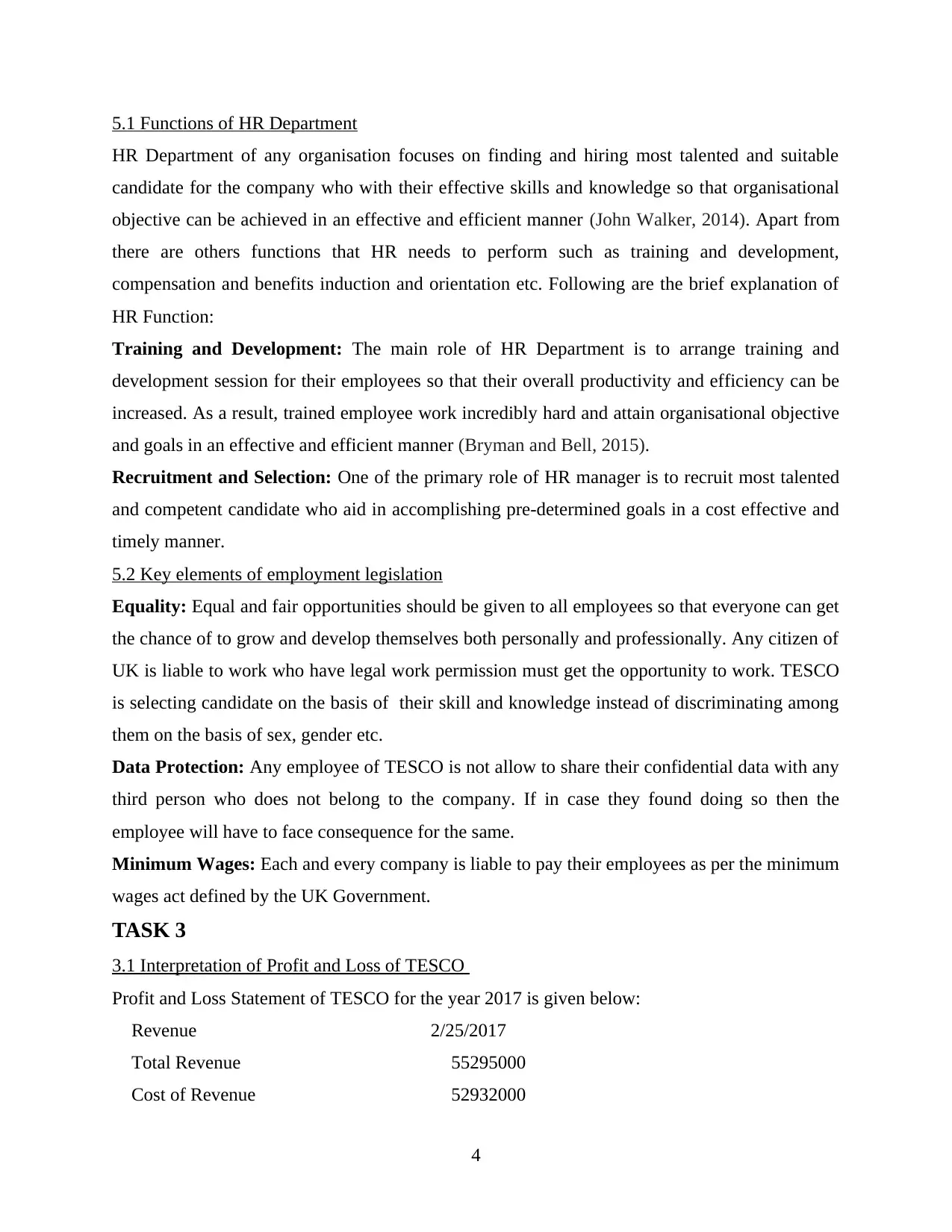
5.1 Functions of HR Department
HR Department of any organisation focuses on finding and hiring most talented and suitable
candidate for the company who with their effective skills and knowledge so that organisational
objective can be achieved in an effective and efficient manner (John Walker, 2014). Apart from
there are others functions that HR needs to perform such as training and development,
compensation and benefits induction and orientation etc. Following are the brief explanation of
HR Function:
Training and Development: The main role of HR Department is to arrange training and
development session for their employees so that their overall productivity and efficiency can be
increased. As a result, trained employee work incredibly hard and attain organisational objective
and goals in an effective and efficient manner (Bryman and Bell, 2015).
Recruitment and Selection: One of the primary role of HR manager is to recruit most talented
and competent candidate who aid in accomplishing pre-determined goals in a cost effective and
timely manner.
5.2 Key elements of employment legislation
Equality: Equal and fair opportunities should be given to all employees so that everyone can get
the chance of to grow and develop themselves both personally and professionally. Any citizen of
UK is liable to work who have legal work permission must get the opportunity to work. TESCO
is selecting candidate on the basis of their skill and knowledge instead of discriminating among
them on the basis of sex, gender etc.
Data Protection: Any employee of TESCO is not allow to share their confidential data with any
third person who does not belong to the company. If in case they found doing so then the
employee will have to face consequence for the same.
Minimum Wages: Each and every company is liable to pay their employees as per the minimum
wages act defined by the UK Government.
TASK 3
3.1 Interpretation of Profit and Loss of TESCO
Profit and Loss Statement of TESCO for the year 2017 is given below:
Revenue 2/25/2017
Total Revenue 55295000
Cost of Revenue 52932000
4
HR Department of any organisation focuses on finding and hiring most talented and suitable
candidate for the company who with their effective skills and knowledge so that organisational
objective can be achieved in an effective and efficient manner (John Walker, 2014). Apart from
there are others functions that HR needs to perform such as training and development,
compensation and benefits induction and orientation etc. Following are the brief explanation of
HR Function:
Training and Development: The main role of HR Department is to arrange training and
development session for their employees so that their overall productivity and efficiency can be
increased. As a result, trained employee work incredibly hard and attain organisational objective
and goals in an effective and efficient manner (Bryman and Bell, 2015).
Recruitment and Selection: One of the primary role of HR manager is to recruit most talented
and competent candidate who aid in accomplishing pre-determined goals in a cost effective and
timely manner.
5.2 Key elements of employment legislation
Equality: Equal and fair opportunities should be given to all employees so that everyone can get
the chance of to grow and develop themselves both personally and professionally. Any citizen of
UK is liable to work who have legal work permission must get the opportunity to work. TESCO
is selecting candidate on the basis of their skill and knowledge instead of discriminating among
them on the basis of sex, gender etc.
Data Protection: Any employee of TESCO is not allow to share their confidential data with any
third person who does not belong to the company. If in case they found doing so then the
employee will have to face consequence for the same.
Minimum Wages: Each and every company is liable to pay their employees as per the minimum
wages act defined by the UK Government.
TASK 3
3.1 Interpretation of Profit and Loss of TESCO
Profit and Loss Statement of TESCO for the year 2017 is given below:
Revenue 2/25/2017
Total Revenue 55295000
Cost of Revenue 52932000
4
Paraphrase This Document
Need a fresh take? Get an instant paraphrase of this document with our AI Paraphraser
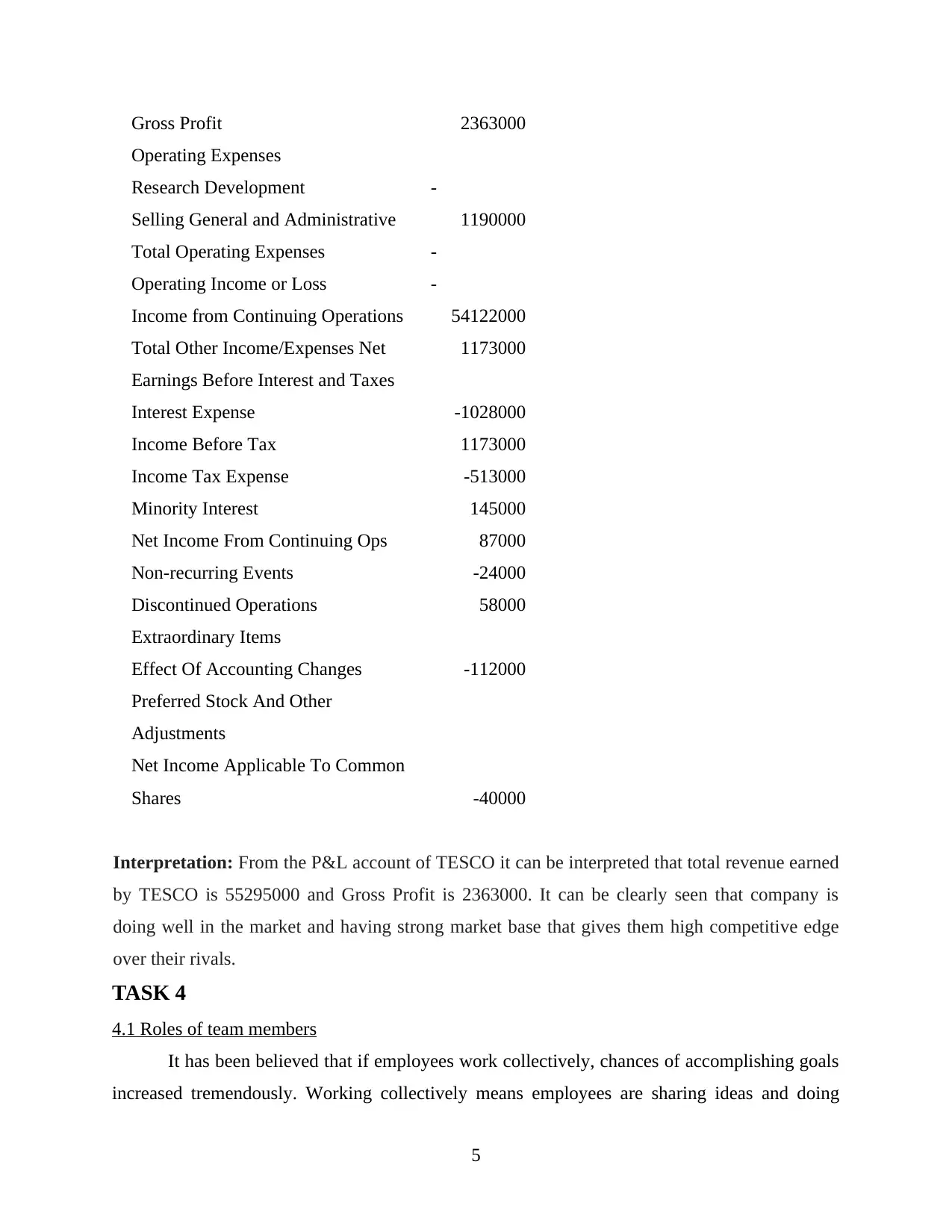
Gross Profit 2363000
Operating Expenses
Research Development -
Selling General and Administrative 1190000
Total Operating Expenses -
Operating Income or Loss -
Income from Continuing Operations 54122000
Total Other Income/Expenses Net 1173000
Earnings Before Interest and Taxes
Interest Expense -1028000
Income Before Tax 1173000
Income Tax Expense -513000
Minority Interest 145000
Net Income From Continuing Ops 87000
Non-recurring Events -24000
Discontinued Operations 58000
Extraordinary Items
Effect Of Accounting Changes -112000
Preferred Stock And Other
Adjustments
Net Income Applicable To Common
Shares -40000
Interpretation: From the P&L account of TESCO it can be interpreted that total revenue earned
by TESCO is 55295000 and Gross Profit is 2363000. It can be clearly seen that company is
doing well in the market and having strong market base that gives them high competitive edge
over their rivals.
TASK 4
4.1 Roles of team members
It has been believed that if employees work collectively, chances of accomplishing goals
increased tremendously. Working collectively means employees are sharing ideas and doing
5
Operating Expenses
Research Development -
Selling General and Administrative 1190000
Total Operating Expenses -
Operating Income or Loss -
Income from Continuing Operations 54122000
Total Other Income/Expenses Net 1173000
Earnings Before Interest and Taxes
Interest Expense -1028000
Income Before Tax 1173000
Income Tax Expense -513000
Minority Interest 145000
Net Income From Continuing Ops 87000
Non-recurring Events -24000
Discontinued Operations 58000
Extraordinary Items
Effect Of Accounting Changes -112000
Preferred Stock And Other
Adjustments
Net Income Applicable To Common
Shares -40000
Interpretation: From the P&L account of TESCO it can be interpreted that total revenue earned
by TESCO is 55295000 and Gross Profit is 2363000. It can be clearly seen that company is
doing well in the market and having strong market base that gives them high competitive edge
over their rivals.
TASK 4
4.1 Roles of team members
It has been believed that if employees work collectively, chances of accomplishing goals
increased tremendously. Working collectively means employees are sharing ideas and doing
5
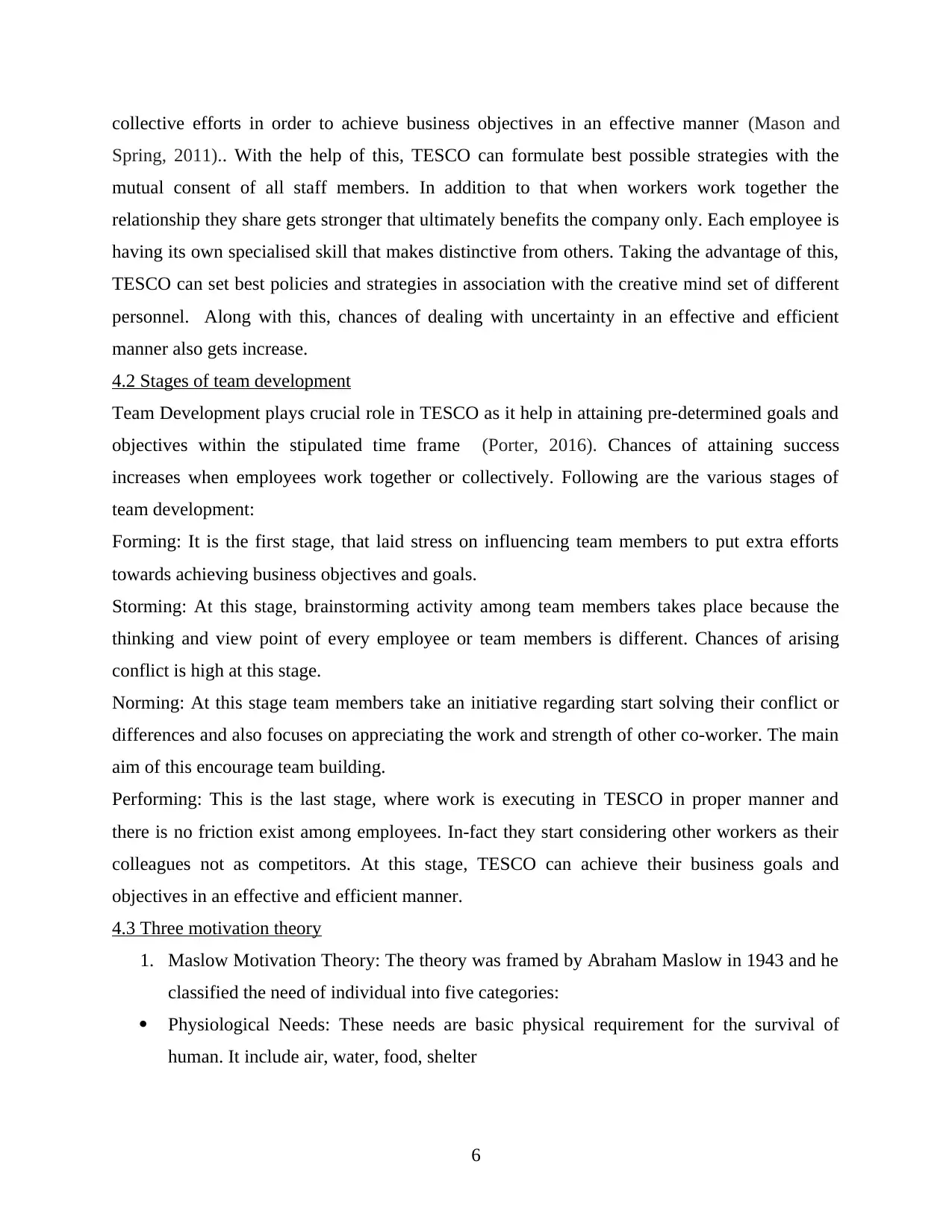
collective efforts in order to achieve business objectives in an effective manner (Mason and
Spring, 2011).. With the help of this, TESCO can formulate best possible strategies with the
mutual consent of all staff members. In addition to that when workers work together the
relationship they share gets stronger that ultimately benefits the company only. Each employee is
having its own specialised skill that makes distinctive from others. Taking the advantage of this,
TESCO can set best policies and strategies in association with the creative mind set of different
personnel. Along with this, chances of dealing with uncertainty in an effective and efficient
manner also gets increase.
4.2 Stages of team development
Team Development plays crucial role in TESCO as it help in attaining pre-determined goals and
objectives within the stipulated time frame (Porter, 2016). Chances of attaining success
increases when employees work together or collectively. Following are the various stages of
team development:
Forming: It is the first stage, that laid stress on influencing team members to put extra efforts
towards achieving business objectives and goals.
Storming: At this stage, brainstorming activity among team members takes place because the
thinking and view point of every employee or team members is different. Chances of arising
conflict is high at this stage.
Norming: At this stage team members take an initiative regarding start solving their conflict or
differences and also focuses on appreciating the work and strength of other co-worker. The main
aim of this encourage team building.
Performing: This is the last stage, where work is executing in TESCO in proper manner and
there is no friction exist among employees. In-fact they start considering other workers as their
colleagues not as competitors. At this stage, TESCO can achieve their business goals and
objectives in an effective and efficient manner.
4.3 Three motivation theory
1. Maslow Motivation Theory: The theory was framed by Abraham Maslow in 1943 and he
classified the need of individual into five categories:
Physiological Needs: These needs are basic physical requirement for the survival of
human. It include air, water, food, shelter
6
Spring, 2011).. With the help of this, TESCO can formulate best possible strategies with the
mutual consent of all staff members. In addition to that when workers work together the
relationship they share gets stronger that ultimately benefits the company only. Each employee is
having its own specialised skill that makes distinctive from others. Taking the advantage of this,
TESCO can set best policies and strategies in association with the creative mind set of different
personnel. Along with this, chances of dealing with uncertainty in an effective and efficient
manner also gets increase.
4.2 Stages of team development
Team Development plays crucial role in TESCO as it help in attaining pre-determined goals and
objectives within the stipulated time frame (Porter, 2016). Chances of attaining success
increases when employees work together or collectively. Following are the various stages of
team development:
Forming: It is the first stage, that laid stress on influencing team members to put extra efforts
towards achieving business objectives and goals.
Storming: At this stage, brainstorming activity among team members takes place because the
thinking and view point of every employee or team members is different. Chances of arising
conflict is high at this stage.
Norming: At this stage team members take an initiative regarding start solving their conflict or
differences and also focuses on appreciating the work and strength of other co-worker. The main
aim of this encourage team building.
Performing: This is the last stage, where work is executing in TESCO in proper manner and
there is no friction exist among employees. In-fact they start considering other workers as their
colleagues not as competitors. At this stage, TESCO can achieve their business goals and
objectives in an effective and efficient manner.
4.3 Three motivation theory
1. Maslow Motivation Theory: The theory was framed by Abraham Maslow in 1943 and he
classified the need of individual into five categories:
Physiological Needs: These needs are basic physical requirement for the survival of
human. It include air, water, food, shelter
6
⊘ This is a preview!⊘
Do you want full access?
Subscribe today to unlock all pages.

Trusted by 1+ million students worldwide
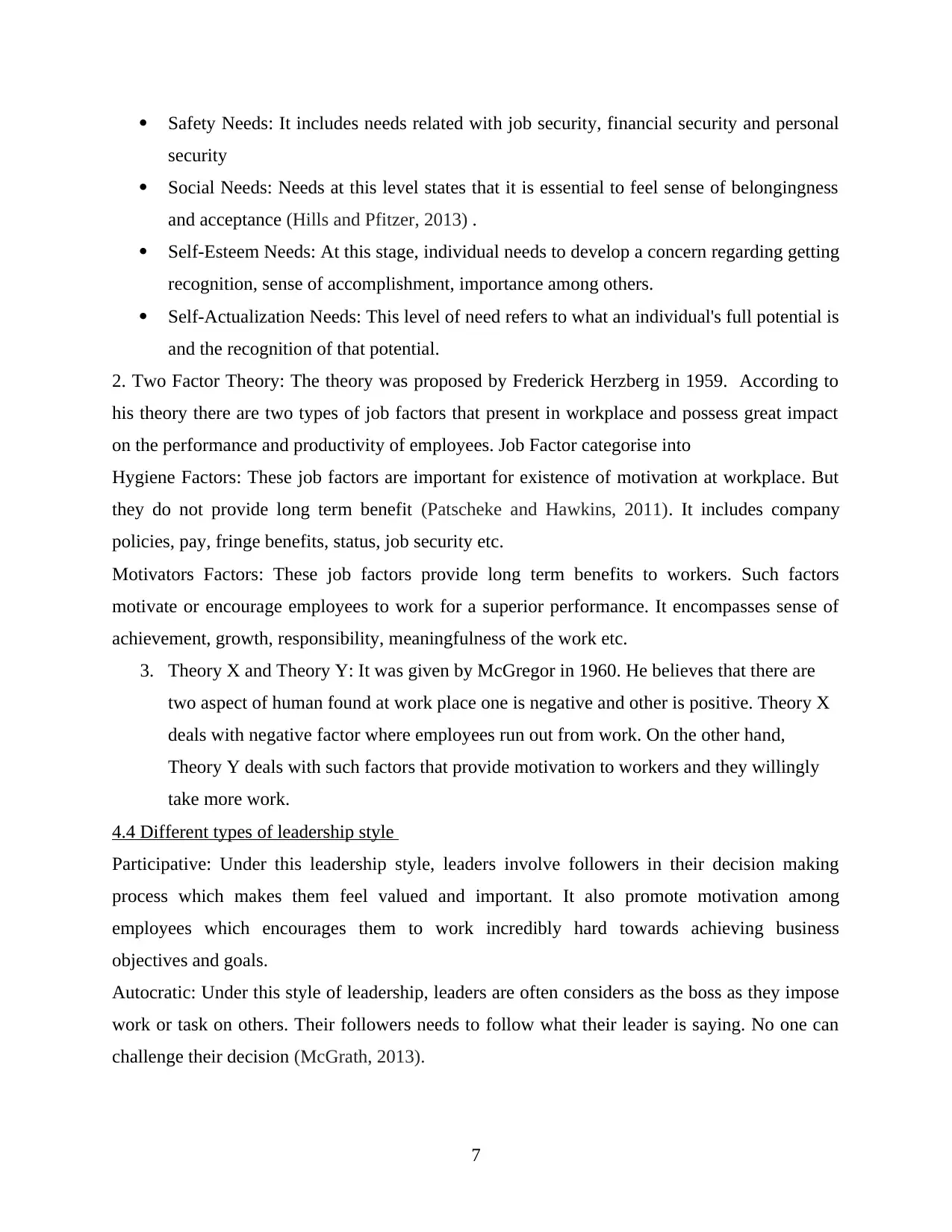
Safety Needs: It includes needs related with job security, financial security and personal
security
Social Needs: Needs at this level states that it is essential to feel sense of belongingness
and acceptance (Hills and Pfitzer, 2013) .
Self-Esteem Needs: At this stage, individual needs to develop a concern regarding getting
recognition, sense of accomplishment, importance among others.
Self-Actualization Needs: This level of need refers to what an individual's full potential is
and the recognition of that potential.
2. Two Factor Theory: The theory was proposed by Frederick Herzberg in 1959. According to
his theory there are two types of job factors that present in workplace and possess great impact
on the performance and productivity of employees. Job Factor categorise into
Hygiene Factors: These job factors are important for existence of motivation at workplace. But
they do not provide long term benefit (Patscheke and Hawkins, 2011). It includes company
policies, pay, fringe benefits, status, job security etc.
Motivators Factors: These job factors provide long term benefits to workers. Such factors
motivate or encourage employees to work for a superior performance. It encompasses sense of
achievement, growth, responsibility, meaningfulness of the work etc.
3. Theory X and Theory Y: It was given by McGregor in 1960. He believes that there are
two aspect of human found at work place one is negative and other is positive. Theory X
deals with negative factor where employees run out from work. On the other hand,
Theory Y deals with such factors that provide motivation to workers and they willingly
take more work.
4.4 Different types of leadership style
Participative: Under this leadership style, leaders involve followers in their decision making
process which makes them feel valued and important. It also promote motivation among
employees which encourages them to work incredibly hard towards achieving business
objectives and goals.
Autocratic: Under this style of leadership, leaders are often considers as the boss as they impose
work or task on others. Their followers needs to follow what their leader is saying. No one can
challenge their decision (McGrath, 2013).
7
security
Social Needs: Needs at this level states that it is essential to feel sense of belongingness
and acceptance (Hills and Pfitzer, 2013) .
Self-Esteem Needs: At this stage, individual needs to develop a concern regarding getting
recognition, sense of accomplishment, importance among others.
Self-Actualization Needs: This level of need refers to what an individual's full potential is
and the recognition of that potential.
2. Two Factor Theory: The theory was proposed by Frederick Herzberg in 1959. According to
his theory there are two types of job factors that present in workplace and possess great impact
on the performance and productivity of employees. Job Factor categorise into
Hygiene Factors: These job factors are important for existence of motivation at workplace. But
they do not provide long term benefit (Patscheke and Hawkins, 2011). It includes company
policies, pay, fringe benefits, status, job security etc.
Motivators Factors: These job factors provide long term benefits to workers. Such factors
motivate or encourage employees to work for a superior performance. It encompasses sense of
achievement, growth, responsibility, meaningfulness of the work etc.
3. Theory X and Theory Y: It was given by McGregor in 1960. He believes that there are
two aspect of human found at work place one is negative and other is positive. Theory X
deals with negative factor where employees run out from work. On the other hand,
Theory Y deals with such factors that provide motivation to workers and they willingly
take more work.
4.4 Different types of leadership style
Participative: Under this leadership style, leaders involve followers in their decision making
process which makes them feel valued and important. It also promote motivation among
employees which encourages them to work incredibly hard towards achieving business
objectives and goals.
Autocratic: Under this style of leadership, leaders are often considers as the boss as they impose
work or task on others. Their followers needs to follow what their leader is saying. No one can
challenge their decision (McGrath, 2013).
7
Paraphrase This Document
Need a fresh take? Get an instant paraphrase of this document with our AI Paraphraser
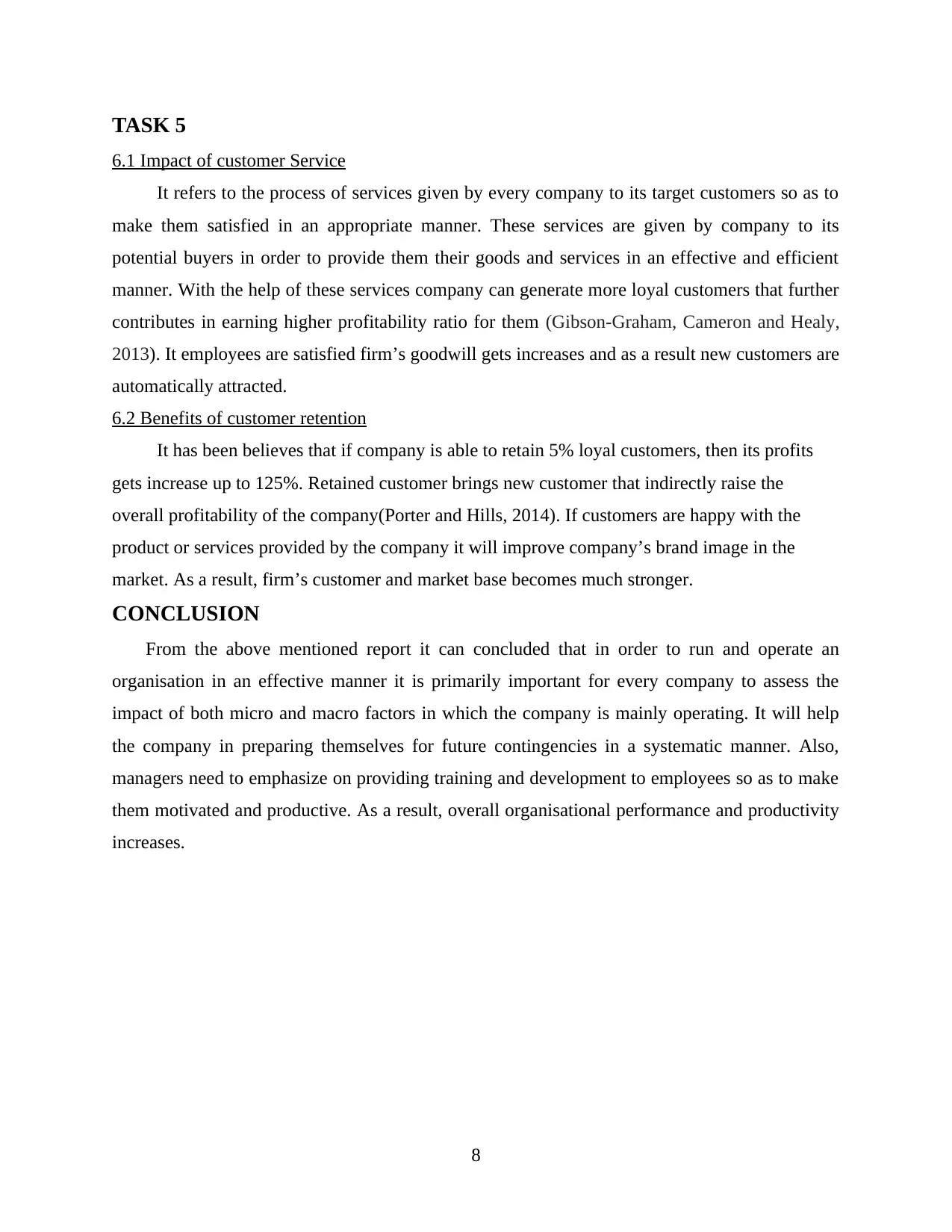
TASK 5
6.1 Impact of customer Service
It refers to the process of services given by every company to its target customers so as to
make them satisfied in an appropriate manner. These services are given by company to its
potential buyers in order to provide them their goods and services in an effective and efficient
manner. With the help of these services company can generate more loyal customers that further
contributes in earning higher profitability ratio for them (Gibson-Graham, Cameron and Healy,
2013). It employees are satisfied firm’s goodwill gets increases and as a result new customers are
automatically attracted.
6.2 Benefits of customer retention
It has been believes that if company is able to retain 5% loyal customers, then its profits
gets increase up to 125%. Retained customer brings new customer that indirectly raise the
overall profitability of the company(Porter and Hills, 2014). If customers are happy with the
product or services provided by the company it will improve company’s brand image in the
market. As a result, firm’s customer and market base becomes much stronger.
CONCLUSION
From the above mentioned report it can concluded that in order to run and operate an
organisation in an effective manner it is primarily important for every company to assess the
impact of both micro and macro factors in which the company is mainly operating. It will help
the company in preparing themselves for future contingencies in a systematic manner. Also,
managers need to emphasize on providing training and development to employees so as to make
them motivated and productive. As a result, overall organisational performance and productivity
increases.
8
6.1 Impact of customer Service
It refers to the process of services given by every company to its target customers so as to
make them satisfied in an appropriate manner. These services are given by company to its
potential buyers in order to provide them their goods and services in an effective and efficient
manner. With the help of these services company can generate more loyal customers that further
contributes in earning higher profitability ratio for them (Gibson-Graham, Cameron and Healy,
2013). It employees are satisfied firm’s goodwill gets increases and as a result new customers are
automatically attracted.
6.2 Benefits of customer retention
It has been believes that if company is able to retain 5% loyal customers, then its profits
gets increase up to 125%. Retained customer brings new customer that indirectly raise the
overall profitability of the company(Porter and Hills, 2014). If customers are happy with the
product or services provided by the company it will improve company’s brand image in the
market. As a result, firm’s customer and market base becomes much stronger.
CONCLUSION
From the above mentioned report it can concluded that in order to run and operate an
organisation in an effective manner it is primarily important for every company to assess the
impact of both micro and macro factors in which the company is mainly operating. It will help
the company in preparing themselves for future contingencies in a systematic manner. Also,
managers need to emphasize on providing training and development to employees so as to make
them motivated and productive. As a result, overall organisational performance and productivity
increases.
8
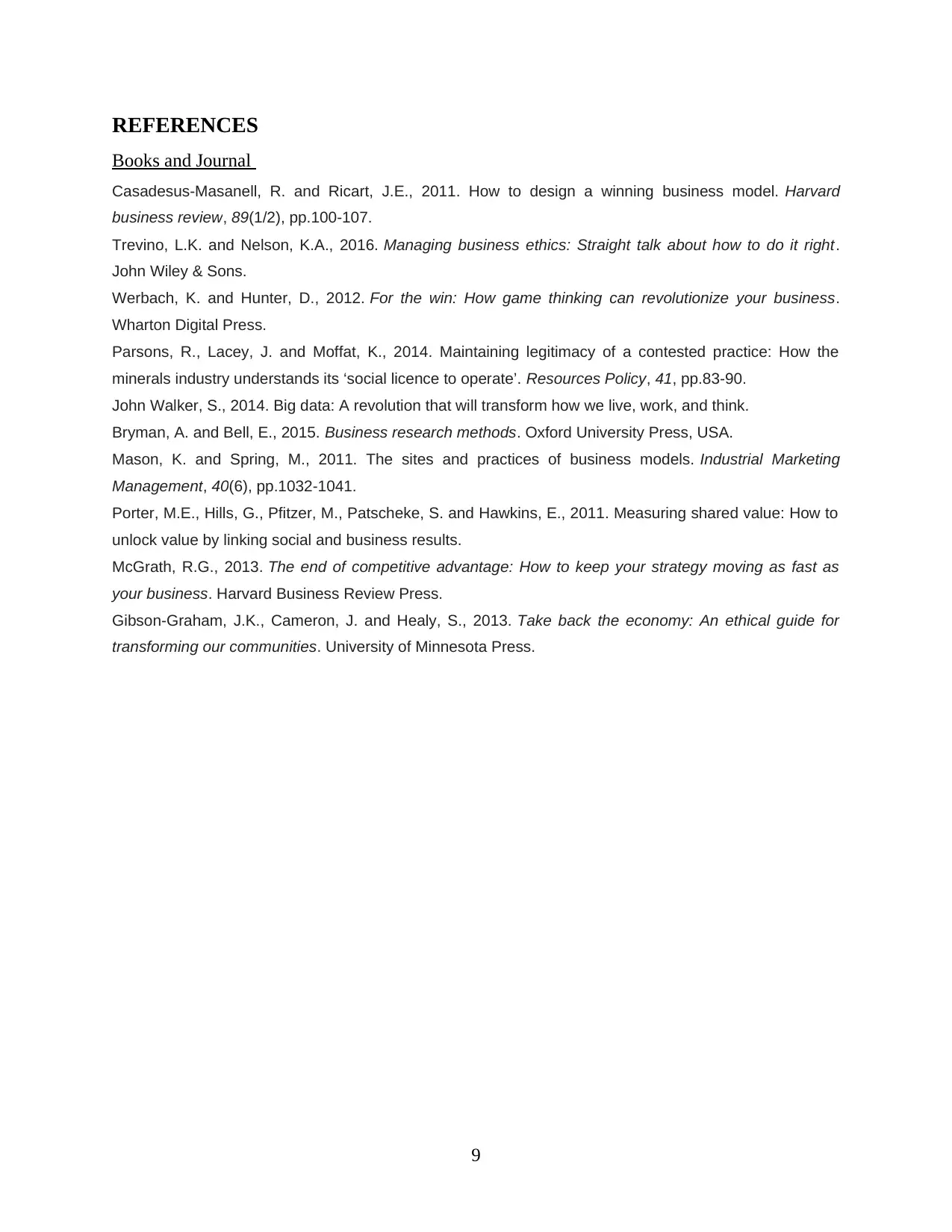
REFERENCES
Books and Journal
Casadesus-Masanell, R. and Ricart, J.E., 2011. How to design a winning business model. Harvard
business review, 89(1/2), pp.100-107.
Trevino, L.K. and Nelson, K.A., 2016. Managing business ethics: Straight talk about how to do it right.
John Wiley & Sons.
Werbach, K. and Hunter, D., 2012. For the win: How game thinking can revolutionize your business.
Wharton Digital Press.
Parsons, R., Lacey, J. and Moffat, K., 2014. Maintaining legitimacy of a contested practice: How the
minerals industry understands its ‘social licence to operate’. Resources Policy, 41, pp.83-90.
John Walker, S., 2014. Big data: A revolution that will transform how we live, work, and think.
Bryman, A. and Bell, E., 2015. Business research methods. Oxford University Press, USA.
Mason, K. and Spring, M., 2011. The sites and practices of business models. Industrial Marketing
Management, 40(6), pp.1032-1041.
Porter, M.E., Hills, G., Pfitzer, M., Patscheke, S. and Hawkins, E., 2011. Measuring shared value: How to
unlock value by linking social and business results.
McGrath, R.G., 2013. The end of competitive advantage: How to keep your strategy moving as fast as
your business. Harvard Business Review Press.
Gibson-Graham, J.K., Cameron, J. and Healy, S., 2013. Take back the economy: An ethical guide for
transforming our communities. University of Minnesota Press.
9
Books and Journal
Casadesus-Masanell, R. and Ricart, J.E., 2011. How to design a winning business model. Harvard
business review, 89(1/2), pp.100-107.
Trevino, L.K. and Nelson, K.A., 2016. Managing business ethics: Straight talk about how to do it right.
John Wiley & Sons.
Werbach, K. and Hunter, D., 2012. For the win: How game thinking can revolutionize your business.
Wharton Digital Press.
Parsons, R., Lacey, J. and Moffat, K., 2014. Maintaining legitimacy of a contested practice: How the
minerals industry understands its ‘social licence to operate’. Resources Policy, 41, pp.83-90.
John Walker, S., 2014. Big data: A revolution that will transform how we live, work, and think.
Bryman, A. and Bell, E., 2015. Business research methods. Oxford University Press, USA.
Mason, K. and Spring, M., 2011. The sites and practices of business models. Industrial Marketing
Management, 40(6), pp.1032-1041.
Porter, M.E., Hills, G., Pfitzer, M., Patscheke, S. and Hawkins, E., 2011. Measuring shared value: How to
unlock value by linking social and business results.
McGrath, R.G., 2013. The end of competitive advantage: How to keep your strategy moving as fast as
your business. Harvard Business Review Press.
Gibson-Graham, J.K., Cameron, J. and Healy, S., 2013. Take back the economy: An ethical guide for
transforming our communities. University of Minnesota Press.
9
⊘ This is a preview!⊘
Do you want full access?
Subscribe today to unlock all pages.

Trusted by 1+ million students worldwide
1 out of 12
Related Documents
Your All-in-One AI-Powered Toolkit for Academic Success.
+13062052269
info@desklib.com
Available 24*7 on WhatsApp / Email
![[object Object]](/_next/static/media/star-bottom.7253800d.svg)
Unlock your academic potential
Copyright © 2020–2025 A2Z Services. All Rights Reserved. Developed and managed by ZUCOL.





